The fight-or-flight response, also known as the acute stress response, refers to the physiological reaction that occurs when in the presence of something mentally or physically terrifying. This response is triggered by the release of hormones that prepare your body to either stay and deal with a threat or to run away to safety.
It’s a survival mechanism which enables us to react quickly when our life is in danger. The hormonal changes and physiological responses that occur in the body help us to run away to safety as quickly as possible or have the strength to fight against the threat.
The fight-or-flight response can happen in the face of imminent physical danger, such as when encountering a growling dog during your morning jog. It can also be the result of a psychological threat, such as preparing to give a big presentation at school or work.
Another example of the flight-or-fight response is if a person who is terrified of heights has to go to the top floor of a skyscraper to attend a meeting. Their body might go on high alert, with their heartbeat and respiration rate increasing. If the response is severe, it can lead to a panic attack.
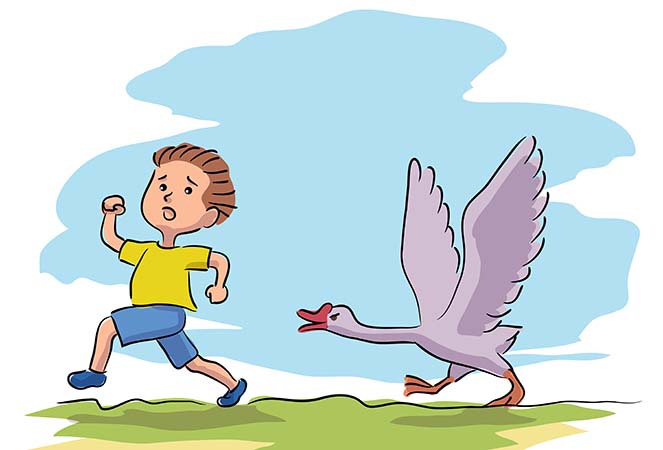
Evolution of the Fight-or-Flight Response
The term “fight-or-flight” represents the choices our ancient ancestors had when faced with danger in their environment: to either fight or flee. In either case, the physiological and psychological response to stress prepares the body to react to the danger.
In the 1920s, American physiologist Walter Cannon was the first to describe the fight-or-flight response. Cannon realized that a chain of rapidly occurring reactions inside the body helped to mobilize the body’s resources to deal with threatening circumstances.
Today, the fight-or-flight response is recognized as part of the first stage of Hans Selye’s general adaptation syndrome, a theory describing the stress response.

What Happens During the Fight-or-Flight Response
In response to acute stress, the body’s sympathetic nervous system is activated by the sudden release of hormones. Fight-or-flight response hormones include adrenocorticotropic hormone and corticotropin-releasing hormone.
These hormones cause the sympathetic nervous system to stimulate the pituitary gland and adrenal glands. This triggers the release of catecholamines, including adrenaline, noradrenaline, and cortisol.
This chain of reactions results in an increased heart rate, blood pressure, and breathing rate.3 Your body can stay in fight-or-flight for 20 to 60 minutes after the threat is gone, which is how long it takes for the parasympathetic nervous system to return it to pre-arousal levels.
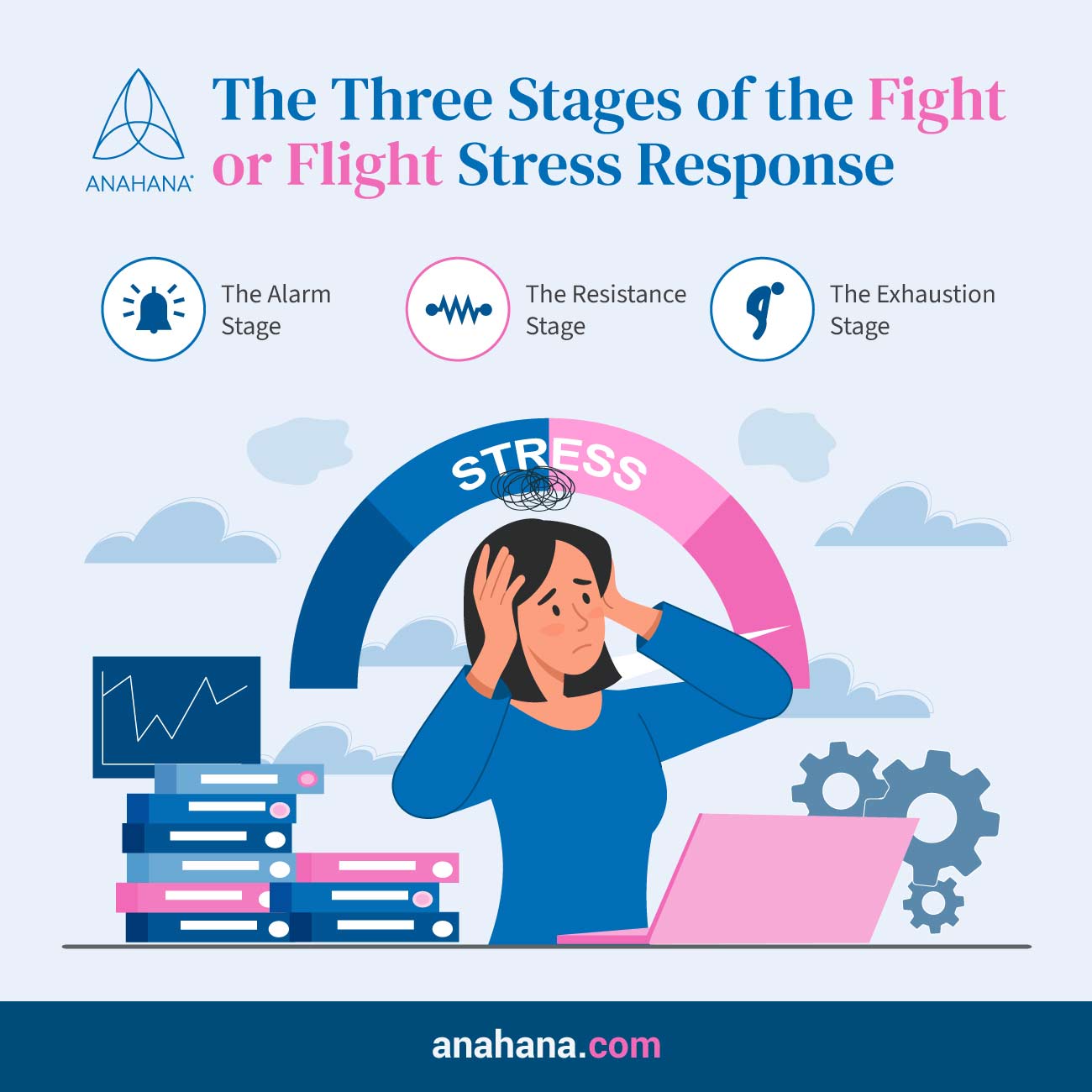
Stages of fight-or-flight
- The alarm stage: During this stage, the central nervous system is ramped up, preparing your body to fight or flee.
- The resistance stage: This is the stage in which the body attempts to normalize and recover from the initial elevated fight-or-flight response.
- The exhaustion stage: If the first two stages occur repeatedly over time, such as when under chronic stress, this can cause the body to feel exhausted and begin to break down.
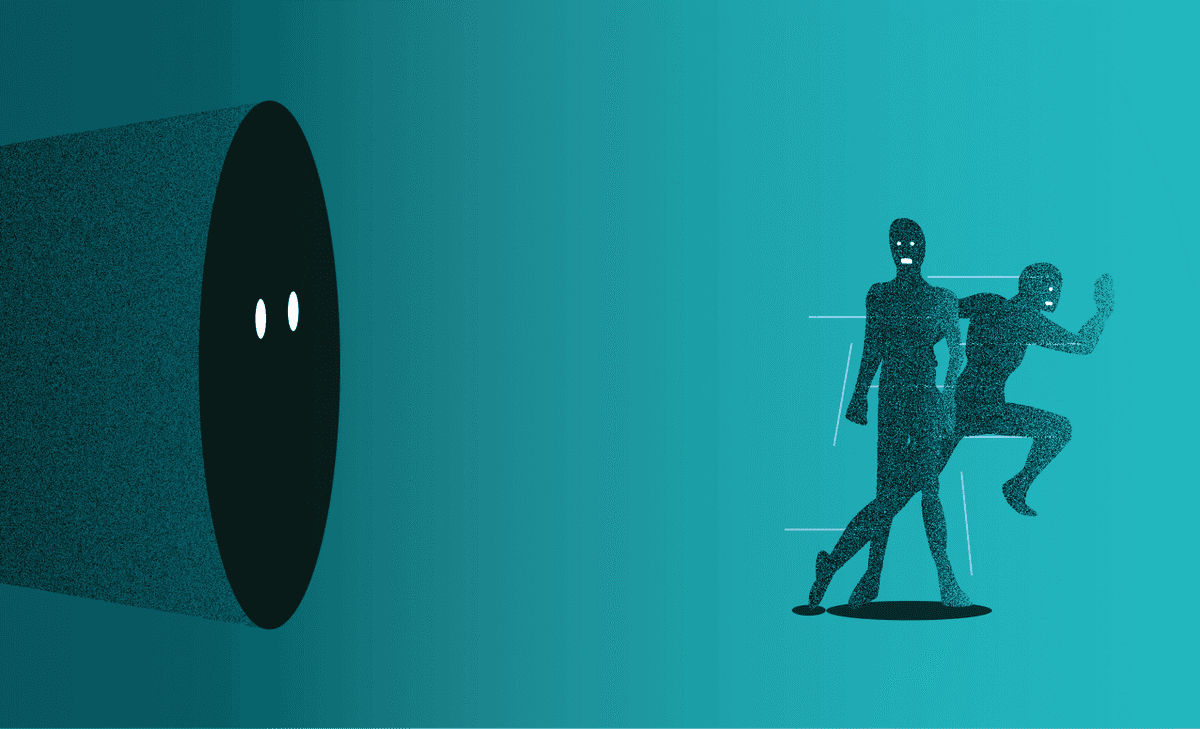
Signs
The stress response occurs when the demands of the environment are greater than our perceived ability to cope with them.
The stress level depends on the individual’s perception of the event and their ability to cope with the event.
E.g., taking an exam might not be perceived as a stressor by someone who has had good results on their test (they feel they can cope) but might be seen as a stressor by another individual who has failed all their tests (they feel they can’t cope this leads to a stress response).
Fight Response
When you feel in danger and believe you can overpower the threat, you are in fight mode. Your brain sends signals throughout your body to rapidly prepare for the physical demands of fighting.
Most signs to tell you are in a fight response include:
- Tight jaw or grinding of the teeth
- Urge to punch someone or something
- Feeling intense anger or killing someone, even yourself
- Desire to stomp or kick
- Crying
- Glaring at people, conserving angrily
- Upset stomach, feels like knots or burning
- Attacking the source of the danger
Flight Response
This is believing you can defeat the danger by running away. In some cases, running away is the best decision. Take a burning building as an example. Unless you are a firefighter, it is best to get out of there as fast as you can.
These emotional and physical responses signify you are in flight mode:
- Excessively exercising
- Feeling fidgety or tense or trapped
- Constantly moving legs, feet, and arms
- Restless body that will not stop moving
- Sensation of numbness in extremities
- Dilated eyes, darting eyes
Freeze Response
When one feels neither like fighting nor flighting, freezing is an option. This list of responses lets you know you are in freeze mode:
- Pale skin
- Sense of dread
- Feeling stiff, heavy, cold, numb
- Loud, pounding heart
- Decreasing in heart rate
- Sensing tolerated stress
Fawn Response
One may use the fawn response after unsuccessfully trying to fight, flight, and freeze. The fawn response is typically prominent in people who grew up in abusive families or situations.
If you are an abused child with narcissistic parents, the only hope of survival would probably be agreement and helpfulness.
Over time, you can recognize this by realizing that regardless of how poorly a person treats you, you are more concerned with making them happy than taking care of yourself.
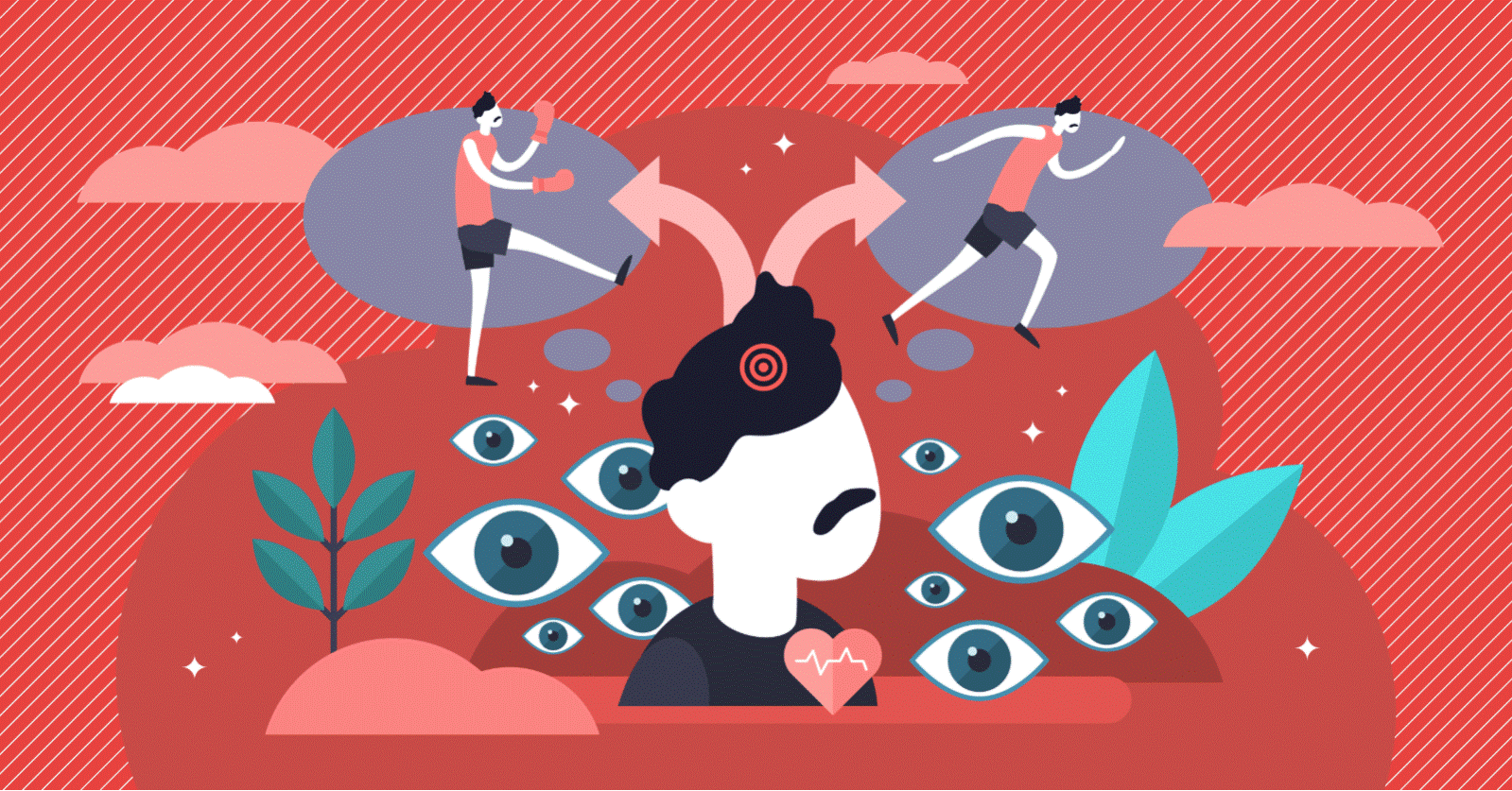
How Fight or Flight Becomes an Anxiety Disorder
The problem isn’t your fight or flight system. The problem is your fight or flight system activating when no danger is present. It’s when your fight or flight symptom is essentially malfunctioning in a way that causes you to experience the effects of the system without any justifiable cause.
Why this system malfunctions isn’t always clear. Chances are it has to do with numerous issues, including:
- Genetics – It’s well known that genetics play a role in the development of anxiety. Being “nervous” is actually something that probably kept early man safe from harm, and so those that exhibited extra nervousness were probably more likely to have children than those that did not. It’s also likely that at some point in history, those genetic traits went a little too far, and started to be passed on from person to person.
- Lack of Dangers It’s also possible that unnecessary anxiety occurs because the world is a safer place. Imagine you have a system in place that’s supposed to be keeping you safe from harm, but then you never experience any scenario that requires it. It’s possible that the system “breaks,” in a way. We see this with dogs. Dogs that do not get to use their instincts, like digging, sometimes experience such profound psychological boredom that they start digging inappropriately in places they shouldn’t be digging.
- Inactivity – One well-supported cause of anxiety is inactivity. This is also an example that we see in dogs. Dogs that don’t get to exercise enough or spend too much time in a crate start to suffer from psychological problems and stress. Human beings were meant to be active, but are living in an increasingly inactive world. That’s why exercise is one of the first and most important anxiety treatments.
- Stress – We may not live in a dangerous world, but we do live in a stressful world. Despite dealing with predators, early man had a somewhat easy life. All they had to do was eat and stay safe. Now, we work full time, we deal with incredibly complex social groups, and more. Anxiety was probably helpful for those under long term stress in the past, because it gave them a sense of urgency to stay away from danger. Now, long term stress is just stress, and damaging to psychological health.
- General Poor Coping Habits Even though the fight or flight response is a physical issue, your mind plays a significant role in perpetuating unnecessary anxiety. Human beings today have bad coping habits and behaviors that cause them more stress or make it harder to control stress. For example, drinking alcohol to temporarily reduce your anxiety makes it harder to use healthy mental coping responses to control your anxiety. Also, watching horror movies or gambling increases stress, which in turn increases your risk for anxiety. All of these types of issues are within your control.
- Behavioral Training Human beings have incredible cognitive skills, and that means that there are many issues in life that can create or encourage anxious behaviors. We learn from our parents, so if they’re anxious we’re more likely to become anxious. We have goals, so if we’re not reaching them we may become anxious. We are social animals, so if our social groups are not kind to us (like a bad workplace), we may become anxious. There are many reasons to see where behavioral training and thought processes play a role in developing anxiety.
As you can see, the cause of anxiety disorders is fairly complex, and there’s no easy way to figure out what the exact issue is. But at the same time, there are certainly some contributing factors that are well established and likely to play a significant role.

Symptoms of the Fight or Flight System
It may be misleading to call the fight or flight effects “symptoms” since the issue is not a disease, but rather a healthy way to stay safe from danger. The following are some of the effects that can be directly attributed to the activation of this response, and why they occur:
- Rapid Heartbeat Your heartbeat speeds up in order to make sure that blood can travel to the areas of your body that need it most.
- Sweating Running/fighting can cause the body to become overheated and fatigued. Sweating occurs to make sure your body stays cool.
- Energy Your fight or flight system affects your glucose levels and uses adrenaline to provide your body with a flood of energy, which may cause you to shake.
- Digestion/Bladder Issues The fight or flight response slows digestion and weakens your bladder because these systems are not considered as important for your physical resources in a moment of danger.
- Hyperventilation The fight or flight response can cause you to breathe more quickly to adapt for the fight. This may result in hyperventilation, which is the cause of many anxiety symptoms such as chest pains, lightheadedness, difficulty breathing, and more.
- Tingling/Cold Limbs Severe anxiety can remove blood from some areas of the body (like the fingers and hands) and move that blood to the heart and other areas that need it.
- Difficulty Thinking In the fight or flight response, overthinking can be dangerous. So the mind makes it harder to think to help you act more on instinct.
- Dilated Pupils Dilated pupils allow you to gather more light, which in turn can help you respond faster to attacks.

How to Cope
Thoroughly understanding your body’s natural fight or flight or freeze or fawn response is a way to help cope with these kinds of situations. When you notice that your body becomes tense, there are steps you can take to try to calm and relax your body.
There is no doubt that the fight or flight response has a distinct purpose and function, but everyday situations like work, bills, kids, finances, and health, can be some of the largest, non-threatening stressors. Stress management is key to your overall health.
The stress response, and precisely the fight or flight or freeze or fawn response, is one of the major topics studied in health psychology. Experts in the field are interested in helping people discover ways to combat stress, which sometimes can be unnecessary, to live healthier, more fruitful lives.
By understanding the fight or flight or freeze or fawn trigger more, psychologists are helping people uncover new strategies for dealing with the natural reaction of stress.
When thinking about the fight or flight or freeze or fawn trigger, it is essential to think big picture when you begin to feel yourself starting to get worked up over something that you know is not a genuine threat or danger.
Learning to slow down, be aware of yourself and your surroundings, and conceptualize what is truly happening to help you regain control is vital.
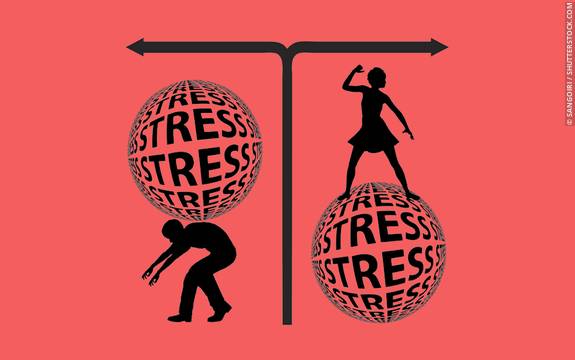
5 coaching tips to avoid experiencing unpleasant physical reactions
It’s important to send positive messages to our brain to let it know that our audience isn’t actually a threat. This is done by establishing good rapport with the people listening to us. Over the years I’ve learned techniques on how to do this and I coach my clients to do the same. Here are some of the tips that help my clients to communicate confidently and comfortably in English:
- Establish positive eye contact with your audience, addressing individuals rather than the whole group. This allows you speak to one person at a time rather than to a big mass of people, which can be very intimidating. I suggest using the Lock, Talk and Pause method:
- Use a lot of pausing during your presentation so as to leave yourself time to breathe and avoid your body panicking. Read more about this technique here:
- Adopt positive body language to let your audience see that you’re confident and to also send the signal to your own brain that you’re feeling comfortable. See Amy Cuddy’s great talk entitled “Your body language may shape who you are”:
- Ensure that you prepare and rehearse your speech well in advance. If you get up on stage not feeling prepared enough there’s a strong risk of panicking. You’ll then send the wrong signals to your brain, telling it that you’re in danger and your body needs to prepare for the worst.
- Use hypnosis and relaxation techniques to reprogramme your brain. You’ll no longer see your audience as a threat. Quite the opposite, you’ll know how to captivate your audience with flowing and impactful talk.
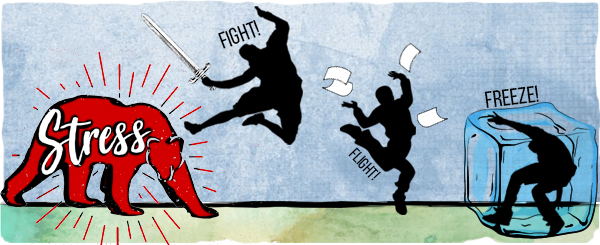
When to Seek Help
When the fight or flight, freeze, or fawn response becomes overly frequent, intense, and activates at the most inappropriate times, this can imply that you are suffering from a range of clinical conditions that include most anxiety disorders.
Again, while the fight or flight or freeze or fawn response has a clear purpose, it should not be activated whenever you do not have to defend your life.
If you feel this could be you, a valuable part of treatment for this kind of anxiety is an improved understanding of the fight or flight or freeze or fawn response’s function, purpose, and process (which is what this article is all about).
For example, patients with post-traumatic stress disorder (PTSD) may confuse the heightened physiological arousal as an indicator of a real threat.
Understanding the fight or flight, freeze or fawn response can help them feel safer by implementing relaxation and grounding techniques.
If you are at a point where stress heavily impacts the quality of everyday living, contact your doctor. Medication, therapy, and stress management strategies can help you reach a more stable state of being.
Here is a specific list of symptoms; you should seek help if you experience any of the following:
- Constantly feeling “on edge.”
- Inability to relax.
- Persistent fear, nervousness, or worry.
- Stress interferes with daily pursuits.
- Intense fear of non-threatening situations.

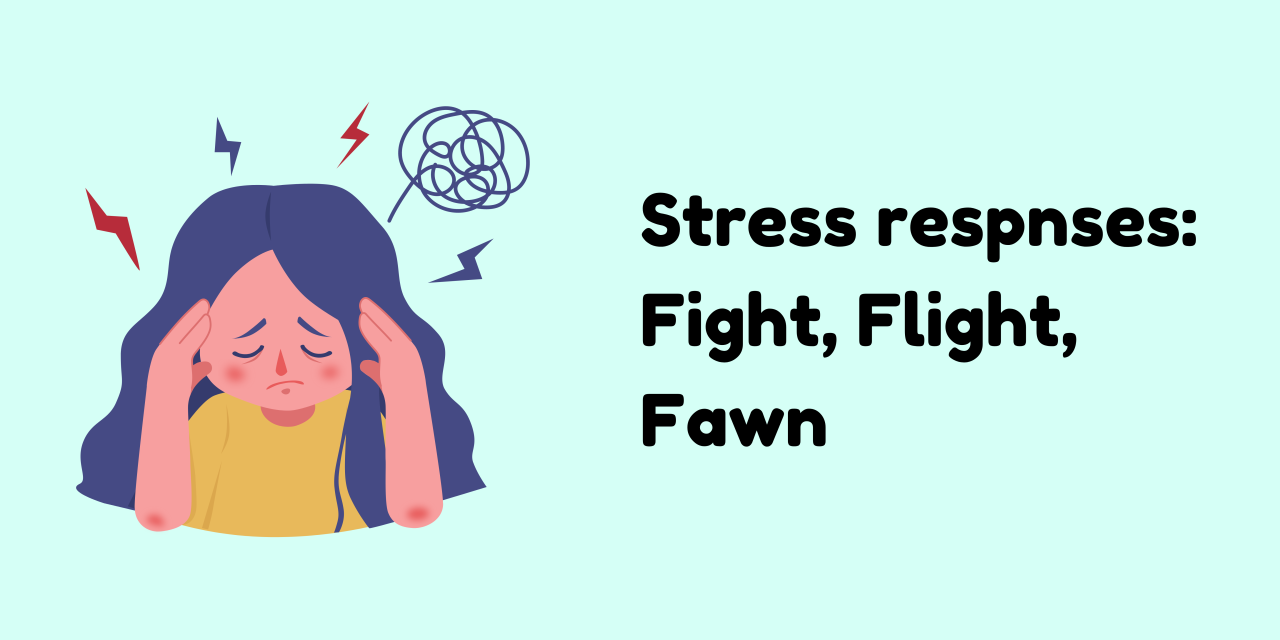












Leave a comment